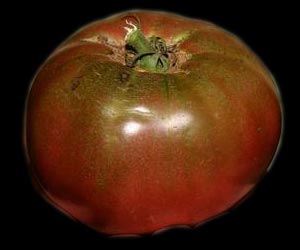

|
No edit summary
|
No edit summary
Tags: Mobile edit Mobile web edit
|
||
| Line 17: | Line 17: | ||
[[File:Developing Cherokee Purple Tomato.JPG|thumb|A Cherokee Purple tomato in the first stages of development.]] |
[[File:Developing Cherokee Purple Tomato.JPG|thumb|A Cherokee Purple tomato in the first stages of development.]] |
||
'''Cherokee Purple''' is the name of a |
'''Cherokee Purple''' is the name of a very old variety of [[tomato]] that develops a fruit with a deep, dusky-rose color while maintaining a somewhat greenish hue near the stem when mature for eating. The deep crimson interior and clear skin combination give it its distinctive color. It was one of the first of the darker color group of tomatoes sometimes described as "blacks"; the variety Purple Calabash, with its highly irregularly shaped fruits, arose in a very few seed catalogs in the mid 1900s. Southern Exposure Seed Exchange was the first seed company to offer Cherokee Purple, released in limited quantity in 1993. |
||
Cherokee Purple tomatoes are beefsteak in style. They are also notable for having a dense, juicy texture, with small seed [[locule]]s irregularly scattered throughout the flesh. The comparatively dark interior color is enhanced by the tendency of the seeds to be surrounded by green gel. In 1995, a skin color mutation of Cherokee Purple arose in Craig LeHoullier's North Carolina garden. It was named Cherokee Chocolate, and the yellow skin gives the variety a brownish mahogany hue. Cherokee Green arose in Craig's garden in 1997 from a planting of Cherokee Chocolate. It is one of several tomatoes whose flesh stays green when it ripens; the skin color is yellow, which provides a guide to indicate when the tomato is ripe and ready for harvest. |
Cherokee Purple tomatoes are beefsteak in style. They are also notable for having a dense, juicy texture, with small seed [[locule]]s irregularly scattered throughout the flesh. The comparatively dark interior color is enhanced by the tendency of the seeds to be surrounded by green gel. In 1995, a skin color mutation of Cherokee Purple arose in Craig LeHoullier's North Carolina garden. It was named Cherokee Chocolate, and the yellow skin gives the variety a brownish mahogany hue. Cherokee Green arose in Craig's garden in 1997 from a planting of Cherokee Chocolate. It is one of several tomatoes whose flesh stays green when it ripens; the skin color is yellow, which provides a guide to indicate when the tomato is ripe and ready for harvest. |
||
This article includes a list of general references, but it lacks sufficient corresponding inline citations. Please help to improve this article by introducing more precise citations. (March 2013) (Learn how and when to remove this message)
|
| Cherokee Purple | |
|---|---|

Cherokee purple is a dusky red with green shoulders when ripe
| |
| Tomato (Solanum lycopersicum) | |
| Maturity | 80 days |
| Type | Heirloom |
| Vine | Indeterminate |
| Plant height | 9 feet |
| Fruit weight | 16 oz |
| Leaf | Regular leaf |
| Color | Dusky red, green shoulders |
| Shape | Beefsteak |


Cherokee Purple is the name of a very old variety of tomato that develops a fruit with a deep, dusky-rose color while maintaining a somewhat greenish hue near the stem when mature for eating. The deep crimson interior and clear skin combination give it its distinctive color. It was one of the first of the darker color group of tomatoes sometimes described as "blacks"; the variety Purple Calabash, with its highly irregularly shaped fruits, arose in a very few seed catalogs in the mid 1900s. Southern Exposure Seed Exchange was the first seed company to offer Cherokee Purple, released in limited quantity in 1993.
Cherokee Purple tomatoes are beefsteak in style. They are also notable for having a dense, juicy texture, with small seed locules irregularly scattered throughout the flesh. The comparatively dark interior color is enhanced by the tendency of the seeds to be surrounded by green gel. In 1995, a skin color mutation of Cherokee Purple arose in Craig LeHoullier's North Carolina garden. It was named Cherokee Chocolate, and the yellow skin gives the variety a brownish mahogany hue. Cherokee Green arose in Craig's garden in 1997 from a planting of Cherokee Chocolate. It is one of several tomatoes whose flesh stays green when it ripens; the skin color is yellow, which provides a guide to indicate when the tomato is ripe and ready for harvest.
The Cherokee purple tomato is most commonly available in the summer and fall. This tomato is best enjoyed fresh and is often used in BLT sandwiches and salads. It can also be used when making pizza and pasta.[1]
Craig LeHoullier received seeds of an unnamed purple tomato from John D. Green of Sevierville, Tennessee in 1990. The accompanying letter indicated the Cherokee Indian origin of the tomato in the late 1800s. After growing the tomato in his 1991 garden, confirming the unique purplish coloration and considering the history shared by Mr Green, Craig named the variety Cherokee Purple and sent it to Jeff McCormack of Southern Exposure Seed Exchange. Jeff enjoyed the flavor of the tomato and his company first listed the variety in its 1993 seed catalog. Its popularity and availability has grown steadily since then.
NPR story on the origins of the Cherokee Purple
This fruit-related article is a stub. You can help Wikipedia by expanding it. |
This Solanales article is a stub. You can help Wikipedia by expanding it. |
This vegetable-related article is a stub. You can help Wikipedia by expanding it. |